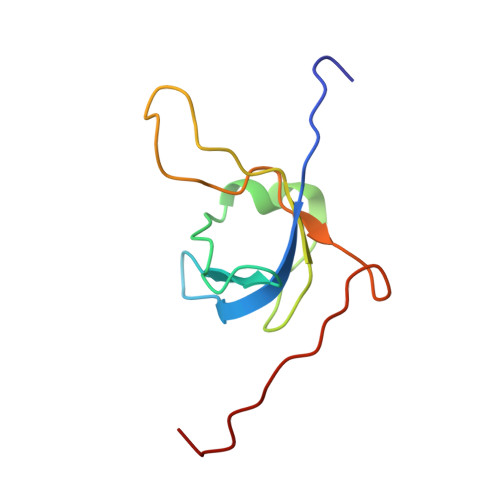The NMR solution structures of the five constituent cold-shock domains (CSD) of the human UNR (upstream of N-ras) protein.
Goroncy, A.K., Koshiba, S., Tochio, N., Tomizawa, T., Inoue, M., Watanabe, S., Harada, T., Tanaka, A., Ohara, O., Kigawa, T., Yokoyama, S.(2010) J Struct Funct Genomics 11: 181-188
- PubMed: 20213426
- DOI: https://doi.org/10.1007/s10969-010-9081-z
- Primary Citation of Related Structures:
1WFQ, 1X65, 2YTV, 2YTX, 2YTY - PubMed Abstract:
Upon cold shock, the amounts of most proteins dramatically decrease from normal levels, but those of cold shock proteins (CSPs) and proteins containing cold-shock domains (CSDs) greatly increase. Although their biological function is still not completely clear, cold-shock proteins might control translation via RNA chaperoning. Many cold-shock proteins contain the motifs (Y/F)GFI and (V/F)(V/F)H, which are known as ribonucleoprotein (RNP)-1 and RNP-2 motifs implicated in RNA/DNA binding. We determined the solution NMR structures of all five constituent CSDs of the human UNR (upstream of N-ras) protein. The spatial arrangements of the sidechains in the RNP-1 and RNP-2 motifs are mostly conserved; however, the conformations of the following residues in the first CSD are different: F43 and H45 (the first phenylalanine residue and the histidine residue in the putative binding site RNP-2) and Y30 (the first residue in the putative binding site RNP-1). F43 and H45 affect each other, and H45 is further influenced by C46. The altered binding site of the first CSD, and its putatively enhanced intrinsic stability, may provide an explanation for the observation that the first CSD has 20-fold higher RNA-binding activity than the fifth CSD. It also lends support to the hypothesis that the UNR protein arose by repeated duplication of a protein that originally contained just one CSD, and that the proto-UNR protein acquired cysteine C46 by mutation during evolution.
- RIKEN Systems and Structural Biology Center, 1-7-22 Suehiro-cho, Tsurumi-ku, Yokohama, Kanagawa 230-0045, Japan.
Organizational Affiliation:
















